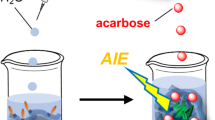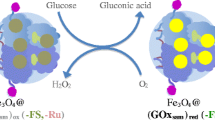Abstract
Fluorescent nanoparticles containing covalently bound phenylboronic acids (~ 250 nm in diameter) are presented that respond to carbohydrates by swelling which is detected using fluorescence resonance energy transfer. The nanoparticles are characterized in terms of kinetics, response time and dynamic range. The response of the particles to glucose at pH 7.5 depends on the kind of phenylboronic acid and on ionic strength. The particles were immobilized in hydrogel sensor layers that enable continuous optical sensing of carbohydrates.






Similar content being viewed by others
References
Kumar A, Srivastava A, Galaev IY, Mattiasson B (2007) Smart polymers: physical forms and bioengineering applications. Prog Polym Sci 32(10):1205–1237
Iwai K, Matsumura Y, Uchiyama S, Silva APD (2005) Development of fluorescent microgel thermometers based on thermo-responsive polymers and their modulation of sensitivity range. J Mater Chem 15(27–28):2796–2800
Suzuki A, Tanaka T (1990) Phase transition in polymer gels induced by visible light. Nature 346(6282):345–347
Schmaljohann D (2006) Thermo- and pH-responsive polymers in drug delivery. Adv Drug Delivery Rev 58(15):1655–1670
Mao J, McShane MJ (2006) Transduction of volume change in pH-sensitive hydrogels with resonance energy transfer. Adv Mater 18(17):2289–2293
Miyata T, Uragami T, Nakamae K (2002) Biomolecule-sensitive hydrogels. Adv Drug Delivery Rev 54(1):79–98
Koschwanez HE, Reichert WM (2007) In vitro, in vivo and post explantation testing of glucose-detecting biosensors: current methods and recommendations. Biomaterials 28(25):3687–3703
Ravaine V, Ancla C, Catargi B (2008) Chemically controlled closed-loop insulin delivery. J Control Release 132:2–11
Cai Q, Zeng K, Ruan C, Desai TA, Grimes CA (2004) A wireless, remote query glucose biosensor based on a pH-sensitive polymer. Anal Chem 76(14):4038–4043
Podual K, Doyle FJ, Peppas NA (2000) Glucose-sensitivity of glucose oxidase-containing cationic copolymer hydrogels having poly(ethylene glycol) grafts. J Control Release 67(1):9–17
Mader HS, Wolfbeis OS (2008) Boronic acid based probes for microdetermination of saccharides and glycosylated biomolecules. Microchim Acta 162(1):1–34
Matsumoto A, Kurata T, Shiino D, Kataoka K (2004) Swelling and shrinking kinetics of totally synthetic, glucose-responsive polymer gel bearing phenylborate derivative as a glucose-sensing moiety. Macromolecules 37(4):1502–1510
Lapeyre V, Gosse I, Chevreux S, Ravaine V (2006) Monodispersed glucose-responsive microgels operating at physiological salinity. Biomacromolecules 7(12):3356–3363
Hoare T, Pelton R (2007) Engineering glucose swelling responses in poly(N-isopropylacrylamide)-based microgels. Macromolecules 40(3):670–678
Zhang Y, Guan Y, Zhou S (2006) Synthesis and volume phase transitions of glucose-sensitive microgels. Biomacromolecules 7(11):3196–3201
Matsumoto A, Ikeda S, Harada A, Kataoka K (2003) Glucose-responsive polymer bearing a novel phenylborate derivative as a glucose-sensing moiety operating at physiological pH conditions. Biomacromolecules 4(5):1410–1416
Zhang S, Chu L, Xu D, Zhang J, Ju X, Xie R (2008) Poly(N-isopropylacrylamide)-based comb-type grafted hydrogel with rapid response to blood glucose concentration change at physiological temperature. Polym Adv Technol 19(8):937–943
Zhang Y, Guan Y, Zhou S (2007) Permeability control of glucose-sensitive nanoshells. Biomacromolecules 8(12):3842–3847
Lapeyre V, Ancla C, Catargi B, Ravaine V (2008) Glucose-responsive microgels with a core-shell structure. J Colloid Interface Sci 327(2):316–323
Hoare T, Pelton R (2008) Charge-switching, amphoteric glucose-responsive microgels with physiological swelling activity. Biomacromolecules 9(2):733–740
Horgan AM, Marshall AJ, Kew SJ, Dean KES, Creasey CD, Kabilan S (2006) Crosslinking of phenylboronic acid receptors as a means of glucose selective holographic detection. Biosens Bioelectron 21(9):1838–1845
Alexeev VL, Sharma AC, Goponenko AV, Das S, Lednev IK et al (2003) High ionic strength glucose-sensing photonic crystal. Anal Chem 75(10):2316–2323
Worsley GJ, Tourniaire GA, Medlock KES, Sartain FK, Harmer HE et al (2007) Continuous blood glucose monitoring with a thin-film optical sensor. Clin Chem 53(10):1820–1826
Samoei GK, Wang W, Escobedo JO, Xu X, Schneider H et al (2006) A chemomechanical polymer that functions in blood plasma with high glucose selectivity. Angew Chem Int Ed 45(32):5319–5322
Ivanov AE, Thammakhet C, Kuzimenkova MV, Thavarungkul P, Kanatharana P et al (2008) Thin semitransparent gels containing phenylboronic acid: porosity, optical response and permeability for sugars. J Mol Recognit 21(2):89–95
Kuzimenkova MV, Ivanov AE, Thammakhet C, Mikhalovska LI, Galaev IY et al (2008) Optical responses, permeability and diol-specific reactivity of thin polyacrylamide gels containing immobilized phenylboronic acid. Polymer 49(6):1444–1454
Ben-Moshe M, Alexeev VL, Asher SA (2006) Fast responsive crystalline colloidal array photonic crystal glucose sensors. Anal Chem 78(14):5149–5157
Alexeev VL, Das S, Finegold DN, Asher SA (2004) Photonic crystal glucose-sensing material for noninvasive monitoring of glucose in tear fluid. Clin Chem 50(12):2353–2360
Lee Y, Pruzinsky SA, Braun PV (2004) Glucose-sensitive inverse opal hydrogels: analysis of optical diffraction response. Langmuir 20(8):3096–3106
Holtz JH, Holtz JSW, Munro CH, Asher SA (1998) Intelligent polymerized crystalline colloidal arrays: novel chemical sensor materials. Anal Chem 70(4):780–791
Zenkl G, Mayr T, Klimant I (2008) Sugar-Responsive fluorescent nanospheres. Macromol Biosci 8(2):146–152
Shiomori K, Ivanov AE, Galaev IY, Kawano Y, Mattiasson B (2004) Thermoresponsive properties of sugar sensitive copolymer of N-isopropylacrylamide and 3-(acrylamido) phenylboronic acid. Macromol Chem Phys 205(1):27–34
Elmas B, Onur M, Şenel S et al (2002) Temperature controlled RNA isolation by N-isopropylacrylamide-vinylphenyl boronic acid copolymer latex. Colloid Polym Sci 280(12):1137–1146
Springsteen G, Wang B (2002) A detailed examination of boronic acid-diol complexation. Tetrahedron 58(26):5291–5300
Matsumoto A, Yoshida R, Kataoka K (2004) Glucose-Responsive polymer gel bearing phenylborate derivative as a glucose-sensing moiety operating at the physiological pH. Biomacromolecules 5(3):1038–1045
Lee M, Kabilan S, Hussain A, Yang X, Blyth J, Lowe CR (2004) Glucose-sensitive holographic sensors for monitoring bacterial growth. Anal Chem 76(19):5748–5755
Kuzimenkova MV, Ivanov AE, Galaev IY (2006) Boronate-containing copolymers: polyelectrolyte properties and sugar-specific interaction with agarose gel. Macromol Biosci 6(2):170–178
Pan X, Yang X, Lowe CR (2008) Evidence for a cross-linking mechanism underlying glucose-induced contraction of phenylboronate hydrogel. J Mol Recognit 21(4):205–209
Acknowledgements
Klaus Koren and the FELMI-ZMF institute are gratefully thanked for preparing and taking the SEM pictures. Herbert Motter is thanked for the digestion and the measurements on the ICP-OES.
Author information
Authors and Affiliations
Corresponding author
Electronic supplementary material
Below is the link to the electronic supplementary material.
Supporting Information
Materials, synthesis of the monomers, measurement methods and additional figures can be found in the Supporting Information of the on-line version of this article. (PDF 858 kb)
Rights and permissions
About this article
Cite this article
Zenkl, G., Klimant, I. Fluorescent acrylamide nanoparticles for boronic acid based sugar sensing — from probes to sensors. Microchim Acta 166, 123–131 (2009). https://doi.org/10.1007/s00604-009-0172-0
Received:
Accepted:
Published:
Issue Date:
DOI: https://doi.org/10.1007/s00604-009-0172-0




